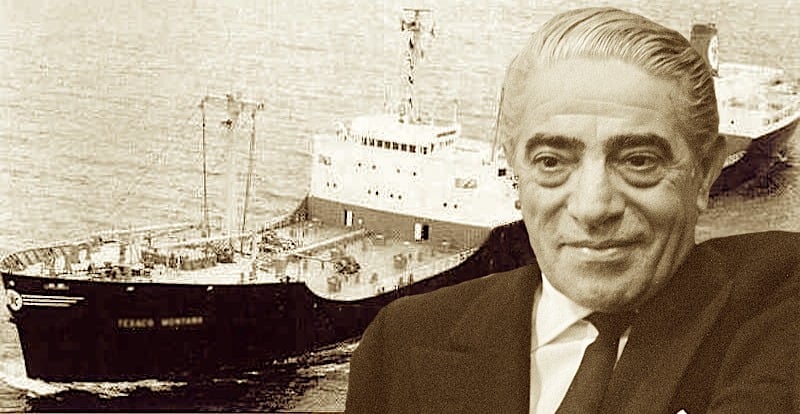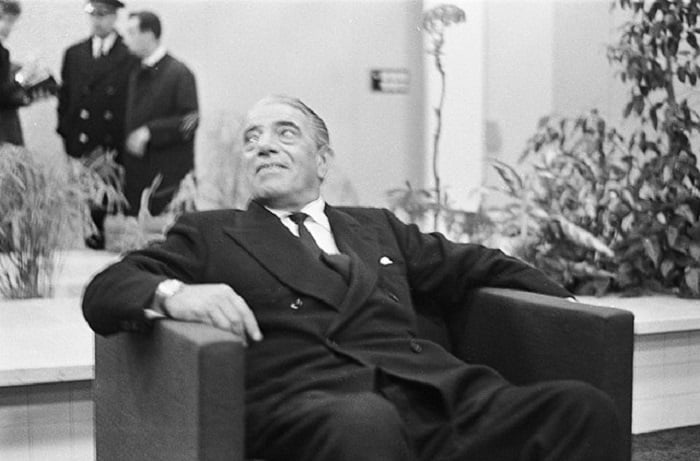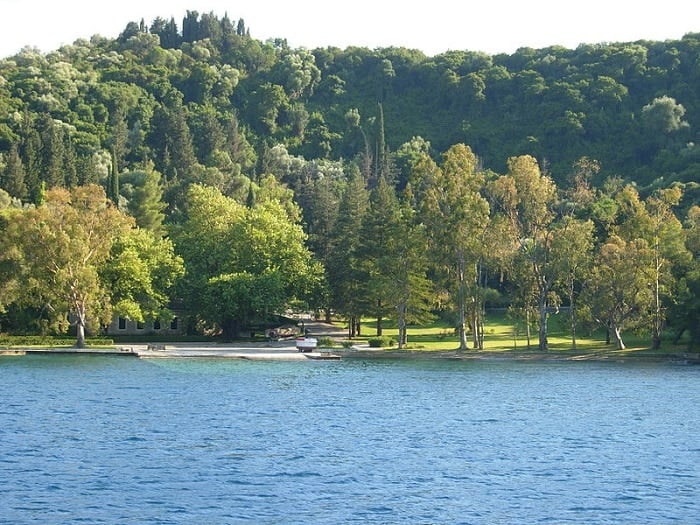 Aristotle Onassis. Credit: Greek Reporter illustration. CC BY-SA 3.0 nl
Aristotle Onassis. Credit: Greek Reporter illustration. CC BY-SA 3.0 nlAristotle Onassis was one of the most famous Greeks in the entire world in the 20th century, a visionary who became one of the richest men in modern history.
Unlike most of the world’s tycoons, Aristotle Onassis was not born to aristocracy or into the realm of the ultra-rich. His father was wealthy, but the fortune the young man made was entirely on his own because he was a true visionary.
The young man from Smyrna was unknown to the rest of the world in the beginning of the 1920s, but by the 1950s he heard his name spoken across the world and his achievements admired globally.
How did this young boy from Smyrna manage to amass a fortune while becoming one of the most successful businessmen in the world and a larger-than-life figure who will never be forgotten?
The history of Onassis is a story of good choices, smart moves, dogged perseverance — and maybe even a little bit of good luck, even though he claimed he didn’t believe in the latter.
A catastrophe opens the way to opportunity
Aristotle Socrates Onassis was born on January 15 or 20, 1906 in Karatas, a suburb of the port city of Smyrna (now İzmir, Turkey) to Socrates Onassis and Penelope Dologou.
His father was a successful tobacco trader and was able to send his children to prestigious schools. When Onassis graduated from the local Evangelical Greek School at the age of 16, he spoke four languages: His native Greek, Turkish, English and Spanish.
Onassis was only 16 when in September 1922 his birthplace was burned down by Turkish troops, forcing the Greeks to abandon their homes and wealth and flee to Greece.
During the burning of the city, Onassis lost four uncles, an aunt, and a cousin who were burned to death in a church where 500 Christians were seeking shelter from the Great Fire of Smyrna.
Onassis along with the majority of ethnic Greeks fled to the homeland. A year later he left Athens using a Nansen passport as a stateless refugee, choosing to take up residence in Buenos Aires, Argentina.
Speaking four languages, he managed to secure a job in the British United River Plate Telephone Company. His clever and tenacious character led him to make the most out of his routine job at the telephone company.
Having endured hardships of every kind, and being obliged to live a life of poverty for years, Onassis didn’t hesitate to dream big. And his dreams were very large indeed.
Legend has it that his life was about to change forever when he overheard a telephone call about an idea to create a new type of cigarette which would be targeted toward women.
Onassis thought perhaps he could begin production of this type of cigarette on his own. Soon, he put his plan into action by creating an Argentine import-export company and making a fortune importing English-Turkish tobacco to Argentina.
He created his own brand of cigarettes, and introducing cigarettes with pink tips aimed at the female market. Using clever marketing practices, including having a Greek singer use his cigarettes, Onassis began to amass his huge fortune.
At the age of 25, he had become a millionaire, which led him to his next major decision.
The lure of the shipping industry
Having been exposed to the shipping world through his tobacco-importing business, Onassis realized that much more money could be earned if he changed his business model to that of shipping only.
Soon after he established his first-ever shipping and trading company, known as ”Astilleros Onassis”, the Greek businessman saw his enterprise expand.
During the Great Depression, while many businesses were being shut down all over the world, Onassis bought his first vessels — for less than half of their real value. This enabled him to build a giant of a company with very little capital.
He named his first ship “Kalliroi”, after his sister. Another two take the names of his parents, “Onassis – Penelope” and “Onassis – Socrates”.
Soon, Onassis made another shrewd business decision, to move his base to New York, while at the same time keeping his offices in Buenos Aires and Athens open.
The Onassis fleet of freighters and tankers was expanding, eventually exceeding seventy vessels. Most of the fleet operated under flags of convenience, a common practice among shipowners.
Onassis’ fleet had mostly Panamanian and Liberian flags and sailed tax-free while operating at low cost. This and his astute business sense helped Onassis amass enormous profits in the highly competitive shipping market.
The Greek shipowner made large profits when the Big Oil companies like Mobil, Socony, and Texaco signed long-term contracts known as “time charters” at fixed prices before the spot market fell.
Onassis: “Crises give birth to moguls”
In the early 1950s, Onassis had bought even more tankers and tried to strike a deal with the King of Saudi Arabia to transport oil from the Arabian-American Oil Company (ARAMCO) with his fleet.
However, Saudi Arabia had a deal with the U.S. which the American government would not allow to change and in 1954 blocked Onassis’ efforts to deal with the Saudis. That left Onassis with several tankers remaining idle.
By 1956, with many of his tankers sitting idle for over two years, the Greek shipowner considered selling his entire fleet off to Royal Dutch Shell, but luckily for him, he didn’t.
According to Franky Brady’s book “Onassis: An Extravagant Life,” the Greek tycoon’s luck turned almost overnight.
In 1956, Egypt was at war with Israel. Cairo nationalized the Suez Canal to bar passage to Israeli ships. Soon, all ships were barred and the canal remained closed for six months, causing a tremendous international bottleneck in the transport of goods.
The impasse forced tankers to circumvent the entire continent of Africa. “Onassis had many extra ships, not under contract, that could be leased to handle the demand,” Brady wrote. “He possessed the power to charge whatever rates he could.”
According to the biographer, prior to the canal blockage, transporting oil from Saudi Arabia to Europe cost $4 per ton. Onassis was charging over $60 — with each tanker-full earning him a profit of over $2 million a trip.
Onassis made more money in a shorter period than he had ever made in his life. The following year, Onassis was estimated to have amassed several hundred million dollars in profits.
However, Onassis had been criticized for making these profits while disregarding the standards that normally govern international shipping.
For example, after his Liberian registered tanker SS Arrow ran aground and spilled oil into Chedabucto Bay, Nova Scotia in 1970, the most significant oil spill off Canada’s East Coast, there was a Commission of Inquiry.
The Commission found that the Arrow had been operating with almost none of its navigation equipment – such as radar and echo sounder – being serviceable.
Also, the ship’s third officer, who was on watch at the time of the accident, was found that he had no license, while none of the crew had any navigational skill except the master.
 The Greek tycoon. Public Domain
The Greek tycoon. Public DomainOnassis expands to other businesses
In 1956, TAE Greek National Airlines faced serious financial difficulties and the government decided to pass the company on to the private sector. On July 30, 1956, Onassis signed a contract granting him the operational rights to the Greek air transport industry.
Operations effectively started in 1957, and the following year saw 244,000 passengers transported. In the 1960s, Onassis turned Olympic Airways into a model airline.
The 1960s was the golden era of the air carrier. The acquisition of cutting-edge technology, like Comet 4B jets, staff training and five-star service made Olympic Airways internationally popular.
Service quality was exceptional. Gourmet food was served with gold-plated utensils — and candles — in first class, while all air hostesses wore futuristic Pierre Cardin uniforms.
During 1974, the last year of Onassis’ involvement with the company, Olympic Airways transported 2.5 million passengers and had a work force of 7,356 persons.
At the time, Onassis was one of the only two men in the world to own a private airline, the other being American tycoon Howard Hughes of TWA.
The agreement with the Greek government lasted until December 10, 1974, when a series of strikes, shortages of passengers, fuel price increases, and a law forbidding Olympic Airways to fire employees, led Onassis to terminate his contract.
Between 1950 and 1956, Onassis was involved in a profitable whaling project off the west coast of South America. Characteristically, his first expedition made a net profit of $4.5 million.
The Onassis factory ship and its catcher ships bent the rules by not paying attention to restrictions regarding whaling.
In 1954 the government of Peru claimed the Onassis fleet were whaling within 200 miles of the coast of Peru without permission. Peruvian vessels then took the vessels of the Onassis whaling fleet into custody.
In 1956, the Greek mogul was forced to sell his whaling enterprise to a Japanese company.
In 1953, Onassis purchased the shares of Monaco’s Société des bains de mer de Monaco (SBM). His aim was to build luxury hotels for an exclusive clientele, a project that initially had the support of Prince Rainier III of Monaco.
While Monaco was a tax haven at the time of purchase, in 1962 French President Charles de Gaulle boycotted Monaco by lifting tax privileges for the principality.
Prince Rainier wished to build hotels and attract a greater number of tourists, but Onassis was reluctant to invest in hotels without a guarantee from Rainier that no other competing hotel development would be permitted.
The two men remained at odds for the rest of their lives, ending up in the French courts to in a bid to adjudicate the matter. In 1967 Onassis decided to sell his SBM shares and leave Monaco for good.
The Greek tycoon’s wealth was already immense. He owned shares that secured his control of 95 multinational businesses on five continents.
Onassis owned gold-processing plants in Argentina and Uruguay, a large share in an airline in Latin America and $4 million worth of investments in Brazil.
He owned companies like Olympic Maritime and Olympic Tourist; a chemical company in Persia; apartments in Paris, London, Monte Carlo, Athens, and Acapulco — not to mention a castle in South France.
He also owned the 52-story Olympic Tower in Manhattan; another building in Sutton Place; Olympic Airways and Air Navigation; the Greek island of Skorpios; and the 99.06 -meter (325 foot) long luxury yacht “Christina O.”
 View of the Greek island of Skorpios. Credit: Shadster/Wikipedia/ CC BY-SA 3.0
View of the Greek island of Skorpios. Credit: Shadster/Wikipedia/ CC BY-SA 3.0The legendary Skorpios island
For Aristotle Onassis, the most priceless of all his acquisitions was Skorpios Island, a small, verdant island next to Lefkada in the Ionian Sea.
Skorpios was the Greek tycoon’s personal paradise, his sanctuary and playground, a place to rest and relax — and throw wild parties with VIPs.
Onassis was active himself in planting 200 species of trees and flowers there, creating gardens and orchards where vegetables and fruit were cultivated.
He also built a taverna on the beach, where he used to cook fresh fish and seafood, sitting at a table and drinking ouzo, gazing at the blue-green waters and singing his favorite songs.
Skorpios was a labor of love for the Greek tycoon. It was also the love nest of the two great loves of his life: Maria Callas and Jacqueline Kennedy.
Onassis shared in the planting of the island’s lush vegetation with Callas. Skorpios was their private refuge, an idyllic environment to serve as a setting for their love story.
At the same time Skorpios was famous for the legendary, lavish parties with the world’s VIPs and jet-setters, from Hollywood stars to political figures.
Most of them took place on Onassis’ luxury yacht “Christina,” named after his daughter. Marilyn Monroe, Elizabeth Taylor, Richard Burton, Grace Kelly, Prince Rainier of Monaco and Winston Churchill were just a few of these luminaries.
The fun usually lasted until daylight, with one famous moment being Maria Callas singing duets with Frank Sinatra.
When Jackie Kennedy replaced Callas in the heart of Onassis, she became the next hostess of Skorpios.
Aristotle and Jackie exchanged wedding vows on the mythical island on October 20, 1968. While it was drizzling all day, it did not hamper the VIP guests celebrating and enjoying the glamorous wedding party.
Jackie changed the overall look of the island, starting with the house, which she decorated with her personal friend, famous interior decorator Billy Baldwin.
Jackie loved the seclusion of Scorpios and liked to swim and sunbathe on its most secluded southern beach.
Not that even there could she escape from the paparazzi, however, who spied on the island by sea to record the private moments of the couple.
This is how the nude photos of the famous woman appeared in international media — to which she reacted nonchalantly, with the phrase, “Each one of us is naked until we put on our swimsuit.”
The two women who marked Aristotle Onassis’ life
On December 28, 1946 Onassis married Athina Mary “Tina” Livanos, daughter of shipping magnate Stavros G. Livanos and Arietta Zafrikakis.
The marriage to Livanos’ daughter was the fulfilment of Onassis’ ambition: to prove to the old-money Greek “aristocracy” that he was their equal. At the time, Onassis was 40 and Tina was just 17.
The couple had two children, Alexander in 1948 and Christina in 1950, both born in New York City. Onassis named his famous yacht after Christina.
However, by the mid-1950s the couple was basically separated and the marriage came to an end when Livanos found her husband in bed with a friend of hers at their home in Cap d’Antibes.
The couple was officially divorced in June of 1960, after Onassis’ much-publicized affair with Onassis legendary opera soprano Maria Callas, the first woman that marked his life in a personal way.
The two had met in 1957 during a party in Venice hosted by Elsa Maxwell. After this first encounter, Onassis is quoted as saying to Spyros Skouras: “There was just a natural curiosity; after all, we were the most famous Greeks alive in the world.”
Callas was married to entrepreneur Gianbattista Meneghini at the time. Both she and Onassis divorced their spouses but did not marry each other, although their relationship continued for many years.
However, after the first few years, the relationship was not a rosy one. The downs were much more numerous than the ups, and Onassis became verbally abusive against Callas, a behavior that went on for years.
Onassis was a friend of Jacqueline Bouvier, the widow of U.S. President John F. Kennedy. In his face, Jacqueline Kennedy saw someone who could provide the privacy and security she sought for herself and her children after the assassination of her husband.
The wedding took place on Skorpios, on October 20, 1968. After marrying Onassis, Jacqueline took the legal name of Jacqueline Onassis and consequently lost her right to Secret Service protection, which is an entitlement of a widow of a U.S. president.
Onassis offered Mrs. Kennedy $3 million to replace her Kennedy trust fund, which she would lose because she was remarrying.
The whole marital contract was discussed with Ted Kennedy, the brother of the slain President. For her part, Onassis’ daughter Christina made it clear that she disliked Jacqueline Onassis from the start.
In fact, after the death of her brother Alexander in 1973, Christina convinced her father that Jacqueline carried some kind of curse due to the assassination of John and Robert Kennedy.
Onassis and “Jackie O” — as the paparazzi dubbed Jacqueline Onassis — lived in several places during their marriage, but the VIP parties they threw at Skorpios became legendary.
Death of Onassis and his legacy
On January 24, 1973, Onassis’ son Alexander died after his his personal amphibious airplane, in which he was a passenger, crashed at Hellinikon International Airport in Athens.
The young Onassis — with 1,500 flying hours under his belt by the time of the crash, in his role as President of Olympic Aviation — was instructing a potential new pilot of the plane, Donald McCusker.
Onassis arrived at the hospital in which his son lingered for some time, accompanied by an American neurosurgeon. However, his son’s life could not be saved.
Onassis refused to believe that his son’s death was an accident, believing it was due to the machinations of the United States Central Intelligence Agency (CIA) and the leader of the Greek military junta, Georgios Papadopoulos.
The death of his son had a profound effect on Onassis, both emotionally and physically. He developed myasthenia gravis some time afterward.
Onassis died at age 69 on March 15, 1975 at the American Hospital of Paris in Neuilly-sur-Seine, France. The cause was respiratory failure, a complication of myasthenia gravis.
The Greek tycoon was buried on Scorpios, alongside his son. Onassis’ will established a charitable foundation in memory of his son, the Alexander S. Onassis Public Benefit Foundation, which received 45 percent of his estate.
The remainder of the Onassis estate was left to his daughter, Christina Onassis, who herself died in 1988. Christina’s share has since passed to her only child Athina, at the time making Athina Onassis one of the wealthiest women in the world.
The Onassis Foundation keeps the great visionary’s name alive through philanthropy with the Onassis Stegi and the Onassis Library in Athens, the Onassis Cultural Center in New York City, the Onassis in Los Angeles and the Onassis Foundation in Vaduz, Liechtenstein.
Onassis’ famous quotes
- “At your job you must be serious but in life you must be crazy.”
- “If there weren’t any women, all the money in the world wouldn’t matter.”
- “Never start a job, a battle, or a relationship, if the fear of losing overshadows the prospect of success.”
- “Take care of your body. Be as good as you can with it. Don’t mind the details. Look at me, I look nothing like a Greek God, but I never wasted my time crying over the bad aspects of myself, remember things are only as bad as you think they are.”
- “Every win is an injustice to someone.”
- “The secret in business is knowing something nobody else knows.”
- “The rule is there are no rules.”
- “Be either rich or an enemy of the rich. I understand both, but never be envious of the rich and try to please them at the same time.”
- “After a point, money stops mattering, it stops being the goal; the game is all that matters.”
- “To be happy make sure you are tanned, live in expensive buildings, even if you have to stay in the cellar; go out to expensive restaurants, even if you can only afford one drink; and if you have to borrow, borrow a lot.”
- “Crises give birth to moguls.”
- “I don’t have friends or enemies, I have competitors.”
- “It is in our darkest moments where we have to focus to see the light.”
- “You will understand that if you make things easier for others you will earn their liking.”
- “If someone is mediocre he will pass by unnoticed, if he is outrageously successful, he is suspicious.”
- “To be successful you have to act big, think big, and talk big.”
- “My law in business is to be the one buying, not selling.”
- “The more you have the more you know you don’t have.”
- “I made a big mistake. I never believed that in the world we live in, emotions can overcome every logic in business.”
- “The best deals and the best sex happen outside of boundaries.”

 1 year ago
144
1 year ago
144











 English (US)
English (US)